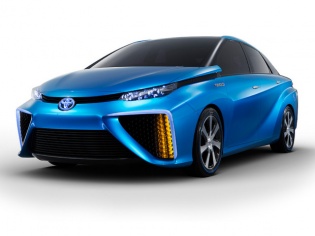-
Alnoor M Peermohamed
18:43 10th Jul, 2014
California Is Betting Big On Fuel-Cell Tech, But Why Is It So Important? | TechTree.com
California Is Betting Big On Fuel-Cell Tech, But Why Is It So Important?
The state will setup 19 hydrogen stations in October 2015, opening up the possibility of selling fuel-cell vehicles.

In the month of October next year, the state of California will get 19 hydrogen fueling stations, making it one of the first functioning hydrogen economies in the world. The move will open up the market for hydrogen fuel-cell vehicles that have several demonstrable advantages over today’s battery electric vehicles.
California has long been the test bed for Hydrogen fuel cell vehicles, but currently the state has just 9 hydrogen stations. The technology has long been touted as the future of emissions free transport and is engaged in a battle with regular electric cars.
The stations will be setup with a $27.2 million grant from the California Energy Commission and a further $7.2 million loan from Toyota. A further 9 stations will be setup soon after October 2015, in order to facilitate the first wave of hydrogen fuel cell vehicles from Toyota, Honda and Hyundai.
Hydrogen fuel cell vehicles are so tantalising because they produce absolutely no emissions, but at the same time have the range of a current gas powered car. Even when the on-board hydrogen reserves run low, all it takes is a top-up at a station, much like a regular car and not hours to charge like a battery electric vehicle.
Toyota's FCV concept for example can store enough hydrogen to drive 480km before needing a refill. That's already 65 km more than the range of Tesla's all-electric Model S, and topping up takes far less time even if the electric car is charged via one of Tesla's superchargers.
[Also read: A Startup Wants To Turn Your Regular Car Into A Self-Driving One]
There are however a few key drawbacks of powering vehicles with hydrogen. The fuel-cell which combines hydrogen with atmospheric oxygen to produce electricty requires a strong catalyst, which can get poisoned in a short period of time. The other major drawback is that the technology is not cheap.
It is for this reason that the deployment of hydrogen fuel stations in California is so important, because the best way to test a technology is to put it to use. Manufacturers looking at the technologies will iron out a great deal of its kinks only if they can get many people to use the vehicles, which should also bring down the cost through mass production.
Hydrogen may be the future of transport, but for now it just isn't there yet. The fight between hydrogen fuel-cell tech and all-electric tech will rage on, but its better to invest in both and hope one succeeds than invest in one and fail.
TAGS: California, Hydrogen Fuel-Cell, electric cars, zero emission
- DRIFE Begins Operations in Namma Bengaluru
- Sevenaire launches ‘NEPTUNE’ – 24W Portable Speaker with RGB LED Lights
- Inbase launches ‘Urban Q1 Pro’ TWS Earbuds with Smart Touch control in India
- Airtel announces Rs 6000 cashback on purchase of smartphones from leading brands
- 78% of Indians are saving to spend during the festive season and 72% will splurge on gadgets & electronics
- 5 Tips For Buying A TV This Festive Season
- Facebook launches its largest creator education program in India
- 5 educational tech toys for young and aspiring engineers
- Mid-range smartphones emerge as customer favourites this festive season, reveals Amazon survey
- COLORFUL Launches Onebot M24A1 AIO PC for Professionals







TECHTREE